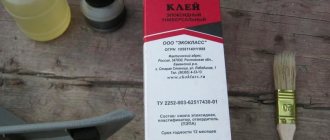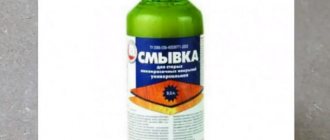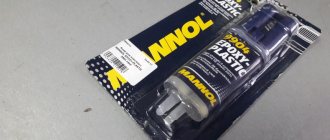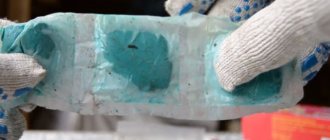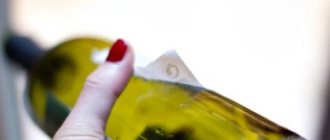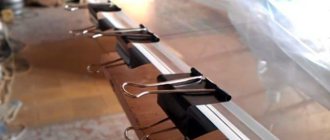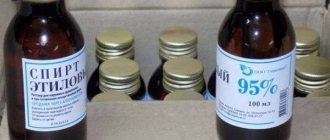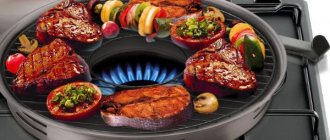Compound
The basis of the composition is epoxy resin. Before gluing it must be mixed with a hardener.
Such an additional component may be polyethylene polyamine, triethylene tetramine or anhydrite. When combined with the resin, the hardener forms a durable polymer substance. The hardener can also be polyamine, carboxylic acids, aminoamides. Hardeners account for 5-15% of the composition. To improve the toughness characteristics, rubber is added to the mixture. To reduce the flammability of the product, organophosphorus modifiers are mixed into it, and laproxy increases the elasticity of the glue.
One-component adhesives contain solvents. On contact with air they evaporate and the mixture hardens. Acetone, xylene, and alcohol can be added to the glue as a solvent. Its content in the composition does not exceed 3%.
- Additionally, synthetic rubber, formaldehyde resin, fiberglass, metal oxides, metal powder, clay or chalk can be mixed into the adhesive mixture.
- To impart plasticity to the mass, its composition can be supplemented with plasticizers that prevent the glue from crumbling after crystallization (for example, phthalic or phosphoric acid). After applying glue with a plasticizer, the seam becomes more elastic and durable. Add. components in epoxy can make up 5-50% of the bulk. While the proportion of fillers that improve performance can reach up to 300%.
Resin with water and amine hardener PEPA
As for contacts of epoxy resins containing hardeners with water or even water vapor, try to avoid them; such contacts may cause the curing epoxy resin to become foggy.
An interesting passage, indeed, but we will not avoid contact “even with water vapor,” but will deliberately introduce water into the curing epoxy composition. The fact is that this process is used to create artistic effects.
For example, adding water to the curing composition at the beginning of polymerization, with thorough mixing, will give a milky-white or cream-colored thickness of the cured polymer.
If adding and mixing water with epoxy was done already at the jelly stage, when the mass is turned with difficulty with a spatula or spatula, then in the transparent thickness of the finished epoxy, transparent stripes and swirls will alternate with the same milky white ones. If the water is colored with water-soluble dyes, the effects will be even more colorful and picturesque.
However, one cannot do without a “but” in this matter: water introduced into the hardening epoxy resin at any stage of this process significantly weakens all of its physical characteristics without exception, making products from it:
- Fragile. Moreover, the areas with the weakest structure will be at the boundaries of the “hardened epoxy resin - water” media. However, with a well-thought-out stirring system, when the spirals and winding lines are located in the same plane, a strong blow to such a frozen workpiece can split the ingot into fancy plates with grooves, from which the water contained in the casting mass will then partially evaporate, which can give interesting artistic results. effects.
- Finely porous. Such castings are made from still liquid resin well mixed with a small amount of water. Which can also serve as a way to get interesting crafts, especially if you make cuts from such frozen ingots, and then carefully polish these cuts.
Possible components and additives
By adding various components to the adhesive, you can improve its performance.
- Powdered aluminum. Increases thermal conductivity and strength of the seam.
- Asbestos improves resistance to temperatures and makes the seam harder.
- Iron oxide colors the seam red and increases its fire resistance.
- Iron powder increases the coefficient of thermal conductivity and heat resistance.
- Soot turns the glue line black.
- Silicon dioxide makes the composition less viscous, but more durable after drying.
- Titanium dioxide turns the transparent glue white.
- Aluminum oxide increases the strength of the composition and its dielectric characteristics.
- Glass fibers and wood chips help add volume to the mixture. This is necessary when filling large voids with epoxy.
History of glue creation
Epoxy glue (glue epoxy) is a popular universal gluing material , the widespread use of which began many years ago and is still popular. Despite the emergence of newer and stronger compounds in the construction field, epoxy effectively glues products that have sufficient density and hardness.
The glue base, epoxy resin or bauxite, was invented in 1938 by Russian chemist Alexander Pavlovich Dianin. The scientist was the first to obtain the key component for the production of this compound - bisphenol A or diphenylolpropane. In honor of him, the name epoxy-diane resins came from. The first batch of this adhesive material was produced in Germany at the beginning of 1940, the first commercial name was Araldite.
In the USSR, they began to use epoxy glue only in 1960, but production immediately began on a large scale, which was envied even in the West. Industrial production was organized in Dzerzhinsk, Sumgait, Kotovsk, Leningrad, and Ufa. The most popular at that time was “Epoxy-Dian”, which had polyethylene, polyamide hardener or “EDP glue”, produced in the city of Dzerzhinsk. Since then, it has been produced in this form; the packaging design has also remained the same - a plastic or glass jar placed in a red and white cardboard package. The form of release has changed only in the Baltic countries - a multi-colored tube.
Areas of use
Epoxy composition has a wide range of applications. Work with glue is carried out in the following areas.
- In construction. The glue is used to fill cracks in concrete, cement screed, reinforced concrete beams, and to seal seams in panel houses. Its use provides the structure with additional strength. They connect iron and concrete parts in the construction of bridges. Epoxy is used to seal insulation, sandwich panels, chipboard, to reduce heat loss, and to finish surfaces with tiles or mosaics. Epoxy is included in primers, putties, and tile mixtures.
- In mechanical engineering. You can glue brake pads and attach plastic and metal parts. The composition is used for repair work, for joining metal or plastic parts. Since the glue is waterproof, it can be used to seal holes in the body or fuel tank, or to restore skins.
- In shipbuilding and aircraft construction. When boats are built, the hull is treated with epoxy to make it waterproof. Fiberglass parts and fastenings of technological units are connected. During aircraft assembly, thermal protection elements are attached. The product is used in the production and fastening of solar panels.
- At home. The composition can be used to repair furniture, shoes, plastic, metal and wooden elements, and to repair equipment. Epoxy is used to seal cracks in glass vases, lampshades, and aquariums. Even parts broken into fragments can be returned to their original shape. The product is used to glue chips of porcelain stoneware, seal cracks in ceramic tiles, and attach hooks or holders to walls. Fashionable architectural designers use epoxy to fill countertops and create designer furniture. It is used in handicrafts and in making souvenirs. The composition is used to secure fasteners in the manufacture of jewelry or hair accessories. They are used to glue sequins, beads, half-beads, lace, satin ribbons, leather, polymer clay, etc.
Where is two-component adhesive used?
The scope of application of such glue is quite wide. It is chosen for restoring damaged furniture, interior accessories, shoes and various small items. Epoxy-based adhesive mass is recommended for use in industrial enterprises.
Before starting use, it is important to read the operating instructions. Thanks to them, it is possible to choose the right solution for independent use.
Properties
- Seam elasticity. Even if the glued surfaces have slight mobility, the seam will not crack or collapse. The elastic seam is not damaged or chipped when drilling or grinding the surface.
- Versatility. Most known materials can be glued.
- Since the adhesive contains solvents, it cannot be used to glue silicone, polyethylene and Teflon bases; there is a high risk of their destruction. The hardened layer of epoxy can be painted or varnished. In addition, it is resistant to solvents, alkalis and oils.
- Frost resistance. The seam does not lose its strength characteristics when the air temperature drops to -30°C, which is why the product can be used for outdoor work.
- Waterproof. After complete hardening, the seam is not susceptible to moisture, water vapor, or condensation.
- Fast drying. The initial coupling takes no more than two minutes. After complete polymerization, it is almost impossible to detach the glued parts.
- Heat resistance. The composition can withstand high temperatures up to +250°C. There are ultra-heat-resistant adhesives that can withstand up to +400°C.
Advantages and disadvantages
The main advantage is versatility in use, but there are other positive aspects
Pros of choosing this glue:
- There is no shrinkage, that is, the volume does not change, since a special seam is formed during the gluing process.
- Cracks do not form on the bonded surface, since the polymer compounds included in the composition are highly elastic.
- It has good adhesive properties to all types of glued materials.
- Resistance to solvents, including aggressive ones, alkaline and oil compounds.
- Quite durable and elastic when temperatures increase to +350 degrees.
- The finished surface can be painted with paint or varnish.
- It has the property of not conducting electric currents and can be used as a dielectric.
- Polymerization itself occurs in all layers of the bonded surface.
- By adding various fillers, you get an adhesive mixture for universal use.
- Resistance of the adhesive composition to moisture.
- It is not subject to destruction when exposed to ultraviolet radiation and open air.
- Can be used as a component of a sliding system.
Disadvantages of the material:
- Before using the two-component type, the compositions must be mixed.
- Strict adherence to safety precautions during work.
- Compliance with the proportions of dilution of the adhesive.
- To complete the work quickly in order to have time before the glue hardens, it is recommended to open the packaging before direct use.
Kinds
There are 3 basic parameters by which epoxy adhesives are classified:
- compound;
- final consistency;
- hardening method.
By composition
- One-component epoxy adhesive. This is a transparent mixture consisting of liquid resin or resin-containing solvent. The glue is packaged in small tubes and does not require preparation before use. The one-component product glues small parts well and is used to seal joints in pipes or cracks and gaps. Most compositions harden on their own. But some brands may only set after high heat.
- Two-component epoxy adhesive. This is the most common form of release. It consists of two components, each of which is packaged in a separate tube. The first tube contains the resin, the second contains the hardener. The second component may have a liquid or powdery consistency. Before use, the resin is mixed with a hardener. The components must be poured into one container and mixed with a spatula. The 2-component composition is applied to the surface within 1-2 minutes after preparation, since after this time it hardens and loses its properties.
Two-component composition in a syringe
By consistency
- Liquid. Such epoxy adhesives need to be squeezed out of the tube. Can be used sparingly as it can be applied to spots. Allows you to glue small parts. Liquid adhesives are often available in syringes. This is a ready-to-use composition.
- Pasty. The product is in the form of a plastic mass with a texture similar to ordinary plasticine. To work, you need to cut off a sufficient amount of paste, knead it and lightly moisten it with water. The finished composition should have a thick consistency. After preparation, it is applied to the surface to be glued.
Epoxy plasticine
By curing method
- Mixtures based on liquefied resin, aliphtic polyamide and plasticizers set quickly, but their complete hardening at t=+20°C occurs in 1-3 days. They take a long time to structure. To increase the strength of the seam, after application it must be thermally treated. Seams not treated with high temperatures are resistant to aggressive acid-base environments. But without heat treatment, the seam will be poorly resistant to prolonged exposure to moisture. This must be taken into account when gluing wooden and other hydrophilic substrates.
- Modifications of adhesive compositions can harden at temperatures from +60 to +120°C. They are used to glue bases, the material of which is characterized by impact strength and increased resistance to the influence of solvents such as oil or gasoline.
- Ultra-strong high-temperature adhesives, for the hardening of which it is necessary to expose the seam to temperatures ranging from +140 to +300°C. Connections of this type have electrical insulating and heat-resistant characteristics.
Main features of the substance
Fast-curing epoxy adhesives quickly polymerize after adding a hardener to the base composition. The hardened mass has the following qualities:
- frost resistance (the mass can easily withstand temperatures down to -20⁰С);
- heat resistance (temperature limit at which the glue retains adhesion: up to +250⁰С);
- good ductility and elasticity, which ensures a high level of gluing strength;
- resistance to aggressive environments (acids, alkalis, oils, petroleum products, household chemicals);
- low shrinkage;
- water-repellent properties and high waterproofing performance;
- excellent interaction with almost all materials.
But you should also be aware of some of the disadvantages of such glue. For example, not all surfaces can be glued together - epoxy cannot bond Teflon, silicone and polyethylene . Take into account the accelerated polymerization time, so if there are flaws during gluing, it will be very difficult to remove them later.
Epoxy glue becomes completely safe only after it has completely cured. Before polymerization, it is toxic and harmful to health. This quality requires compliance with personal safety measures when working.
Glue does not work with all materials
Where is it used?
Due to its high technical qualities and versatility, epoxy adhesive is actively used in a variety of sectors of modern industry. Namely:
- in construction, to connect reinforced concrete structures and panels, glue is used to fill cracks and potholes in concrete, and it is used to lay tiles;
- shipbuilding uses an adhesive substance when installing and assembling ship parts made of fiberglass, plastic and metal; the substance is also used to improve the waterproofing qualities of materials;
- aviation (design), used for gluing various parts, manufacturing and installation of batteries, additional fixation for heat protection;
- mechanical engineering uses epoxy adhesive for mounting equipment, fastening brake pads and various parts when assembling machines, for various repairs.
Types of glue
Experts distinguish two large groups of adhesive epoxy composition. This:
- Liquid. Packaged in tubes. This form of release is convenient and easy to use.
- Plastic bars. Its consistency is similar to plasticine or dough. Also available in tube packaging. After squeezing out, the mass is slightly moistened with water and softened by hand.
Various modified formulations can also be found on sale. The temperature regime for polymerization of such modifications ranges from +60–120⁰С. Such adhesive substances are used for gluing various materials that are resistant to solvents, petrochemicals and oils.
Particularly strong in the line of epoxy adhesives are hot-curing masses (polymerization occurs at a temperature of +140–300⁰С). These modifications are characterized by high heat resistance and electrical insulation characteristics.
Several brands of epoxy glue are common in household and home use. They are recognizable and familiar to almost everyone:
- universal glue Moment;
- Contact intended for sealing pipes, repairing plumbing;
- Cold welding adhesive is intended for gluing metal products.
Is epoxy glue harmful to health?
When working with epoxy-based adhesive, you should be aware that it poses a health hazard. When working with it, the use of personal protective equipment becomes mandatory: gloves, respirator mask and goggles . If the adhesive mass gets into the stomach, a person runs the risk of serious poisoning, and contact with the skin leads to the development of allergic reactions.
Epoxy glue should not be used when gluing dishes and other items in contact with food.
Specifications
| Characteristic | Meaning |
| The basis | Epoxy resin |
| Additional components | Modifiers, hardener, solvent, fillers, plasticizer. |
| Color | White, transparent, yellowish. For metal bases, the adhesive may have a silver, gray or brown tint. In rare cases, the composition may be pink. |
| Working temperature | From +10°С, the higher, the faster the rate of hardening of the composition |
| Curing time | Depends on the composition of the product. Ranges from 3 hours to 3 days. |
| Operating temperature | -20…+120°С. Particularly durable compositions can be operated at t=+250°C |
| Hazard Class | Class 3 - a low-hazard product that can cause irritation and an allergic reaction to the skin. |
| Environmental friendliness | Toxic product, do not allow it to enter water bodies. |
| Shelf life of the prepared product | From 5 minutes to 2 hours, depending on the manufacturer. |
| Composition strength | 100-400 kgf per 1 sq.m. |
| Average density per 1 cubic meter. | 1.37 t. |
| Elasticity upon impact or displacement of the seam | 1000-2000 MPa |
| Solvents | Toluene, acetone. After crystallization, the product is resistant to alkalis, salts, kerosene, gasoline, and acids. |
| Release form | For gluing small surfaces, you can buy epoxy in 6 or 25 ml syringes. The universal composition is available in containers of 140, 280 g, 1 kg. Epoxy like cold welding can be bought in tubes of 45 or 70 ml, it is also available in buckets and bottles of 250 or 500 g. For industrial purposes, the product is produced in barrels of 15, 19 kg. |
Consumption
The consumption of epoxy-based adhesive will depend on the thickness of the applied layer.
The average consumption per 1 m2 with a layer of 1 mm is 1.1 kg.
If porous substrates such as concrete, wood or wooden slabs are pasted over, the consumption increases. To fill voids with a volume of 1 cm cubic. you need to use 1.1 g of the mixture.
How long does it take to dry?
Drying time depends on the ambient temperature and the ratio of the main components in the composition. To speed up the setting of the product, you need to add more hardener to it. To increase the speed of hardening, the adhesive joint can be heated after setting. If you increase the heating temperature, the composition hardens faster.
Epoxy glue dries differently. It all depends on its type.
- Cold welding hardens in 5-20 minutes.
- Liquid mixtures become thick after an hour, set after 2 hours, and completely polymerize within a day.
If the glue does not harden (or takes a very long time to dry), it is possible that it is expired, or the proportions when preparing the mixture were not met.
You should not carry out gluing at sub-zero temperatures, since the adhesive seam does not normally crystallize. To speed up hardening, it is better to carry out work at temperatures from +10 to +30°C.
Temperature
Most brands, after hardening, can withstand heating temperatures up to +150...+180°C, without reducing the strength characteristics of the seam.
Some adhesives are characterized by increased heat resistance, so they can withstand +250°C. There is a type of glue that has increased heat resistance; it holds its shape when exposed to a temperature of +400°C for a short time.
For normal glue hardening, it is enough that the temperature is from +20 to +23°C. Some brands can harden at +10...+15°C.
If the composition needs to be made more liquid, the resin must be heated in a water bath, with a melting point of 50-60°C. After melting, the epoxy is easily drawn up with a syringe and applied pointwise to the prepared surfaces.
On average, the operating temperature is +10...+30°C, but depending on the brand it may differ.
Fast curing EDP adhesive
This product is produced in packages of 45/250 g and is two-component. The first bottle contains epoxy and a number of modifiers, the second bottle contains a hardener. Purpose of fast-curing adhesive:
- connection of composite and metal products, objects made of alloys, ceramics, glass, and other materials,
- repair and sealing of devices,
- sealing chips, defects, cracks.
Typically this type of EAF adhesive is used when fast curing is required. The product replaces cold welding.
Advantages of glue
The adhesive composition has the following advantages:
- ensuring the required level of strength 6 hours after application,
- work at a temperature of 10-30 degrees,
- low labor intensity of the process, the ability to process the adhesive seam even before the end of complete polymerization.
Application of fast-curing EAF
Before use, surfaces should be carefully prepared - cleaned, degreased, and dried. To improve adhesion, sandpaper is used. The bottle with resin is placed in water at a temperature of 60 degrees for 8 minutes. 1.5 parts of epoxy are mixed with 1 part of hardener, the resin lifetime is 30 minutes. You can use any fillers - cement, chalk, alabaster, fibers, graphite in a volume of up to 20%. The composition is applied in a thin layer to both surfaces, connected and pressed. Leave the product in the fixed position for 6 hours. Afterwards it is completely ready for use.
The difference between epoxy glue and resin
Epoxy resin in its composition is a polymer combined with a hardener, and the adhesive based on it is a complex compound that includes modifiers and fillers.
You can distinguish one from the other by certain characteristics.
- Hardening speed. The manufacturer indicates on the glue packaging the exact time for its hardening, which cannot be accelerated or slowed down. The rate of polymerization of the resin can be influenced by external influence.
- Color. The resin is initially transparent. Over time, the shade changes only slightly. The glue is also colorless at first, but over time it turns yellow.
- Scope of application. Resin is added in the manufacture of plastic, putty, primers, paints, and is also used for filling. Glue is used only for repair and construction work.
How to dilute epoxy
Before understanding how to use glue, you need to understand the correct dilution of the two-component type. It is necessary to dilute the main part with the hardener after the preparatory stage, so that it does not have time to dry out ahead of time. For the same reason, you need to mix the quantity in a volume sufficient for application until it hardens, which is prescribed as standard on the packaging.
The mixing proportion may be different for different brands, and the manufacturer indicates it on the glue label; always follow these recommendations. If the resin is too viscous, it will need to be preheated to improve mixing ability. It is acceptable to use a water bath or place the container on a heating device.
Afterwards, you can dilute the elements in a selected clean container, accurately measuring the amount of each component. For small volumes, a syringe is suitable for this purpose.
Add the elements carefully, slowly, and choose a wooden stick for stirring.
It is necessary to dilute the main part with the hardener after the preparatory stage, so that it does not have time to dry out ahead of time.
Stamps
| Name | Description |
| Contact | Effectively used in rooms with high humidity. They can be used to seal pipes, showers, bathtubs, and toilets. |
| Henkel Moment | Two-component “Moment Super Epoxy” adhesive is produced in tubes or syringes with a volume of 5 g or more. The Epoxylin composition is also sold in 30, 48, 100 or 240 g. The product is reliable, durable and easy to use. |
| Super-Grip | This is an equal-component epoxy adhesive containing mineral fillers that increase the strength of the joint. Glues almost any materials. |
| Bison | Transparent gel consisting of two components. It can be used to fill voids, cracks, chips, and restore parts to their original shape. |
| Class | The tool is similar to the previous one. Glues metals, alloys, is used for repairing cars, gluing pipes or sinks. |
| Second | Bonds all surfaces in just three minutes. |
| Novocolor station wagon | It shrinks slightly and has high adhesive ability with different substrates. The product can be used to glue large cracks and chips. |
| Metal Bond | Initial coupling in just 5 minutes. You can glue metal to wood, plastic or other substrates. |
| Compound K-153 | For connecting metal structures that are constantly exposed to moisture or petrochemical products. |
| Ultima (two-component adhesive) | Used in decorative facing works. They can repair vehicles, boats, boats, household appliances or plumbing fixtures. |
| Poxipol | It crystallizes within 10 minutes after mixing, so you need to work with it quickly. |
| EDP | Bonds any surface, from glass to metal. Has good value for money. |
| Epoxy steel | A product for any base. It belongs to autochemical products, since it is often used in car repairs. |
| DoneDeal Epoxy Adhesive | 2-component epoxy adhesive, available in syringes. Creates a tight, airtight, waterproof seam. |
| BisonEpoxy 5 min | Reliably adheres to any surface and has a high polymerization rate. |
| Abro | This is a cold welding that connects bases made of any materials. Can be produced in white and black. |
| Novol Plus | A resin-based product combined with a hardener and fiberglass. You can glue large chips, cracks or defects. |
| Uhu | Connects plastic, metal or used as a fill. |
| Defense-EC | Epoxy resistant to chemicals. Available in 10 kg buckets. Most often used in production. |
| Epoxy Titan | Equivalent product. Has increased strength and resistance to impact loads. Sold in blisters of 20 and 200 ml, in buckets of 2 liters. |
Epoxy adhesives from Moment
EDP
Two-component Poxipol
Types of material
Currently, more than a dozen brands of epoxy adhesive can be found on the building materials market, so it must be correctly classified in order to choose the best option for a specific type of work or for specific conditions. The criteria by which the types of adhesive resins are determined are composition, consistency and method of curing.
The composition classification defines two types of glue: one-component and two-component.
- One-component adhesive is sold in a sealed tube. This tube is filled with resin and solvent. No preliminary preparation of the composition is required. Due to the small volume of the tube, such adhesive compositions are intended for minor repairs or for sealing gaps and joints. But often one-component glue requires elevated temperatures to harden, although models are now being produced that set without preheating.
- At first glance, it seems that one-component adhesive has an advantage, however, two-component compositions are more often found on sale. The set includes two tubes. One of them contains a resin that has a paste-like consistency, and the other contains a powder or liquid hardener. Preparation of epoxy glue is reduced to mixing the contents of the tubes in the proportion specified by the manufacturer. The master must quickly prepare the composition and use it before curing, otherwise the adhesive ability of the resin will disappear.
Useful to know > Which epoxy glue to choose for gluing metal, how to work with it
Instructions for use
To glue materials, you need to first prepare them, then dilute the glue and only then start gluing.
First, dirt, dust, grease and oil stains must be removed from the surface to be pasted, and then completely degreased. Next, the surface is dried, although there are brands of epoxy adhesives that can paste over wet substrates. To increase the adhesive properties of the surface, it can be wiped with sandpaper after drying.
How to properly dilute
How to use epoxy glue and the exact proportions for its preparation are indicated in the instructions. The usual ratio of resin to hardener is 10 to 1. Sometimes it is necessary to prepare in a ratio of 5:1.
At home, it is better to prepare the glue in a separate container, which will then not come into contact with food. A disposable container is suitable for mixing.
- First, the resin is squeezed out of the tube.
- Then the hardener is added.
Mix the ingredients carefully and slowly to prevent a strong thermal reaction in the container. Mixing can be done with a wooden stick or spatula.
If the resin is too thick, it will be difficult to dilute with the hardener. In this case, the component must be dissolved in a water bath at a temperature of up to 50-60°C. To easily dilute the mixture to a uniform consistency, you can place the tube of resin in a pan of hot water before mixing. At the same time, do not allow boiling water to come into contact with the composition, so as not to deteriorate its characteristics.
Since the prepared mixture hardens quickly, you need to mix at a time only the amount that you have time to use before it initially dries.
How to glue
After preparing the surfaces, they need to be lubricated with the prepared glue and pressed tightly against each other. You need to hold them for about 10 minutes. Afterwards, leave until completely hardened (about a day).
For additional fixation, a rope, a vice, or weights can be used.
If small parts are connected, the composition can be applied pointwise with a syringe. The glue is applied to large areas with a brush.
If epoxy is used as a fill, the mold is prepared. Its bottom and sides are treated with fats. Afterwards, the mold is filled with glue and remains in it until completely hardened.
To speed up polymerization, three hours after pouring the glue into the mold, it is sent to the oven for heating. Without additional heating, the glue in the mold hardens no earlier than after a week. If a mold with a thickness of more than 2 mm is poured, then everything is done in stages. After each stage, you need to wait until the previous layer polymerizes.
How to dilute it to a liquid state
A solvent is used to dilute it to a liquid state.
Acetone, xylene, alcohols, and other organic compounds can dissolve epoxy glue.
The amount of thinner should not exceed 3-5% of the dry volume of the resin, as this may negatively affect the adhesive qualities of the composition.
You can dissolve the epoxy in a water bath, heating it to a temperature of 50-60°C.
Top best
The stores have a large selection of epoxy compounds from imported and domestic manufacturers:
- Contact – transparent epoxy glue. Contains: poly epoxy resin, hardener. For use in household repairs. The seam is resistant to aggressive environments (exposure to oil, gasoline, water), does not shrink in any way, and does not expand. Perfectly fills vacuums and cracks. After drying, the product can be used at temperatures from –30 degrees to + 150 degrees. Glass, metal, wood, porcelain can be bonded.
- Moment Super Epoxy is an epoxy adhesive with many functions. It has a colorless structure, has superpowers, glues almost all materials, does not spread out and does not shrink when drying. Suitable for outdoor use. After drying, you can paint over, drill, etc. When the parts are mixed, curing begins within five minutes and high reliability is achieved within an hour. Do not use with polyethylene, Teflon, polypropylene or surfaces that will come into contact with food.
- TechnoNIKOL is a thixotropic epoxy adhesive with two components. The seam is resistant to bending and compression. Provides high adhesion to smooth surfaces. Used for repairing concrete structures, columns, curbs. Fills voids, gaps, cracks. Connects load-bearing and repaired concrete elements. Available in metal and plastic containers.
- G/Flex is an epoxy resin designed for permanent and water-resistant bonding of fiberglass, ceramics, and wood. It has higher elasticity than conventional epoxy or polyester resin, but is thicker and tougher than sealants. Used for connections that will absorb stress, increase, contraction, ripple, shock. After connecting the elements, working time is 45 minutes at room temperature. Hardening occurs after 7 hours, after 24 hours the glued elements can be used.
- Poxypol - two components. Consists of oligomers. The package contains two tubes. Before use, the contents are mixed in equal proportions. When mixed until smooth, a white adhesive composition is obtained. Bonds ceramics, metal, wood, concrete, plastic, glass, rubber. Hardens when exposed to water or oils. You can correct the seam within the first 10 minutes after application. Complete hardening occurs within a day.
Security measures
During work, the room must be thoroughly ventilated. It is better to do gluing in the fresh air. These precautions are necessary because the epoxy mixture produces toxic fumes.
- You need to glue in thick clothing, with a respirator or protective mask on your face.
- Hands are protected with gloves.
- If the mixture gets on exposed skin, it should be washed off immediately with soap and water.
- The container in which the composition is mixed is thrown away after use. Food and drinking water cannot be stored in it, since even a small dose of glue entering the body can cause poisoning.
Precautionary measures
When working with adhesive, it is important to follow safety rules. The substance creates toxic fumes, so use a respiratory protection product that has a carbon filter. Joints should be glued with epoxy glue in an open area or in a ventilated (well ventilated) room.
Before starting to knead the composition, put on rubber gloves. People suffering from allergies should pay special attention to skin protection products. It is prohibited to use tableware for mixing glue components.
How to wash
If the glue gets on a surface that is not to be glued and has not yet had time to harden, it can be cleaned with a soap solution. Stubborn residues can be removed with acetone. The hardened mixture can be removed with liquid vegetable oils, under the influence of which it softens and peels off.
- Freezing. Epoxy can withstand low temperatures down to -20°C, so freezing it in a home freezer is ineffective. It must be removed with an aerosol refrigerant. If you spray it on the adhesive surface, it will become brittle. Afterwards, you need to remove the glue with a spatula or a blunt knife. Removal must be done carefully to avoid injury from glue fragments.
- Heat. The glue softens when heated with a household hair dryer or iron. Solid heat-resistant layers must be heated with a hairdryer with heated air flow at the maximum level for several minutes. The softened areas are scraped off with a spatula. Heat until all excess residue is removed. If epoxy drips onto the fabric, it needs to be heated with an iron, placing a cotton rag on the front side of the material.
- Scraping. Hard, scratch-resistant surfaces can be cleaned of the adhesive mixture mechanically. Any metal tool can be used for this.
- Exposure to chemical solvents. This method cleans wear-resistant materials that are not exposed to aggressive environments. Acetone, alcohol, butyl acetate, aniline, and toluene can be used as a diluent. You need to moisten the contaminated area with any of these products, wait until the glue softens and remove its remains mechanically. You can remove glue from mirror surfaces with acetic acid.
Bonding technology
A good result is obtained if the surface is properly prepared for applying glue. Therefore, you need to understand the features of different bases. Wooden, plastic and metal elements are most often glued; working with them will be described in more detail below.
A good result is obtained if the surface is properly prepared for applying glue.
Plastic
It is possible to glue many types of plastic at home, but you should not use polypropylene and formaldehyde types. First, plastic of an easily glued type is prepared, improving adhesion; sandpaper treatment is required. After the base is degreased, it is permissible to use only ethyl alcohol. When the layer is applied, a load is created on the object in order to obtain a good fixation; the load can be removed in an hour and a half.
When the layer is applied, it creates a load on the object to get a good hold.
Tree
The wood needs to be cleaned of dirt, after which the composition can be applied. The tool you can use is a spatula or a brush. The adhesive layer is applied evenly, the parts are pressed and left until completely hardened.
The parts are pressed and left until completely hardened.
Metal
The metal must be well cleaned in advance, greasy stains must also be removed in order to obtain high-quality adhesion. Well, then using a convenient method, apply glue to the surface and connect them according to the scheme described above. Act carefully; it will be difficult to remove a frozen stain.
Act carefully; it will be difficult to remove a frozen stain.
Storage
Epoxy should be stored in its original packaging at air temperature from +20 to +25°C. The product must be placed in a vertical position in a dry place.
The tube with the mixture should not be placed in direct sunlight; it should also be stored away from children and away from food.
If the container is damaged, the glue will lose its properties.
Shelf life depends on the manufacturer. May last from 1 to 3 years. After this period has expired, the quality of the glue may deteriorate slightly. The fresher the components of the adhesive mixture, the better the polymerization process of the composition, the faster the glue and the surface adhere, and a stronger seam is obtained. If there is still some of them left in the original packaging after mixing the components, you need to store the tubes with resin and hardener in the refrigerator. You must first remove as much air as possible from the tubes. The prepared mixture cannot be stored for long periods of time. After use, any remaining glue must be disposed of.
Types of epoxy based adhesives
Manufacturers are offering more and more new variations of epoxy glue, which makes it more difficult to choose the right one, but below are the main characteristics by which epoxy glue should be classified. The name of the glue will be the same in any case.
Consistency
The adhesive can be supplied in either liquid or solid form. For the first one, everything is simple - just apply it to the surface, and it will immediately begin gluing. In the second, you must first knead the composition, after mixing it with liquid.
Curing method
The glue also hardens when exposed to a certain temperature range. So, for example, there are options that can easily harden at room temperature, while for others even 100 degrees is not enough.
Usually, all the conditions for using glue are written on the packaging, which makes it quite difficult to make a mistake with the choice. What temperature epoxy adhesive can withstand must first be found out from the manufacturer of a particular product.
What temperature can the glue withstand?
Separately, it is worth mentioning the temperature regime at which the glue is able to retain all its properties. Even to work normally with a substance, it must be heated. Operating temperature is about seventy degrees.
Advice
To heat the resin, the container with it must be placed in a basin filled with water at the appropriate temperature.
- The maximum temperature for glue is plus two hundred and fifty degrees.
- The lowest is minus twenty.
This stability is one of the reasons why epoxy adhesive is used not only in domestic conditions, but also in the production of cars, the construction of aircraft, ships and bridges.
We recommend: Types of glue for foam rubber and rules for its use
Mold filler
Resin is good for casting in molds, as shown in the photo. Parts obtained using this method can be machined. The rules by which the mixture is prepared in this case are identical to the rules already described above:
- In this form, glue is often used, for example, by aircraft modellers;
- To give the product any color, various dyes are added to the resin, as shown in the photo;
- And to make it as plastic as possible - plasticizers.
The following are used as fillers for epoxy resins:
- powders;
- textiles of synthetic origin;
- glass fiber;
- and other substances.
Let's sum it up
Epoxy glue is a substance whose properties many have heard of. However, the features of the application and characteristics of such glue are not known to many. With its help you can achieve a high-quality and durable connection. However, to prepare the substance you will need to follow the rules described above.
